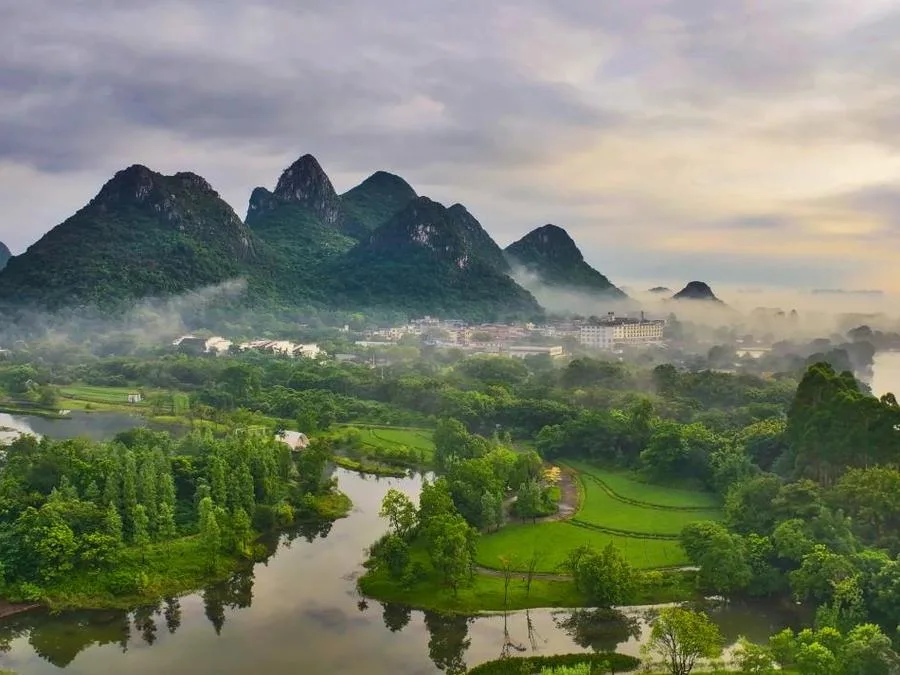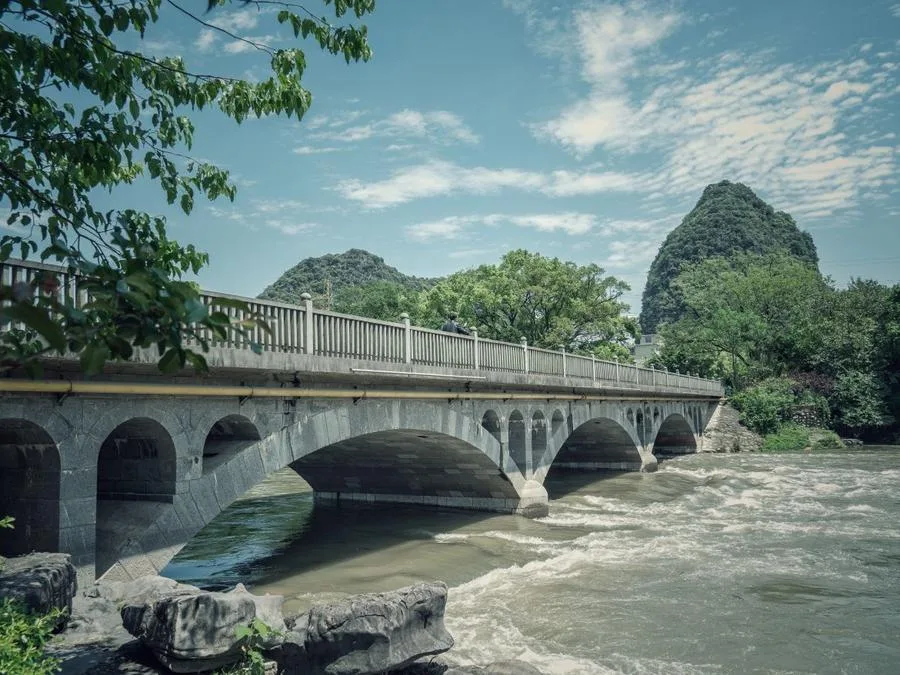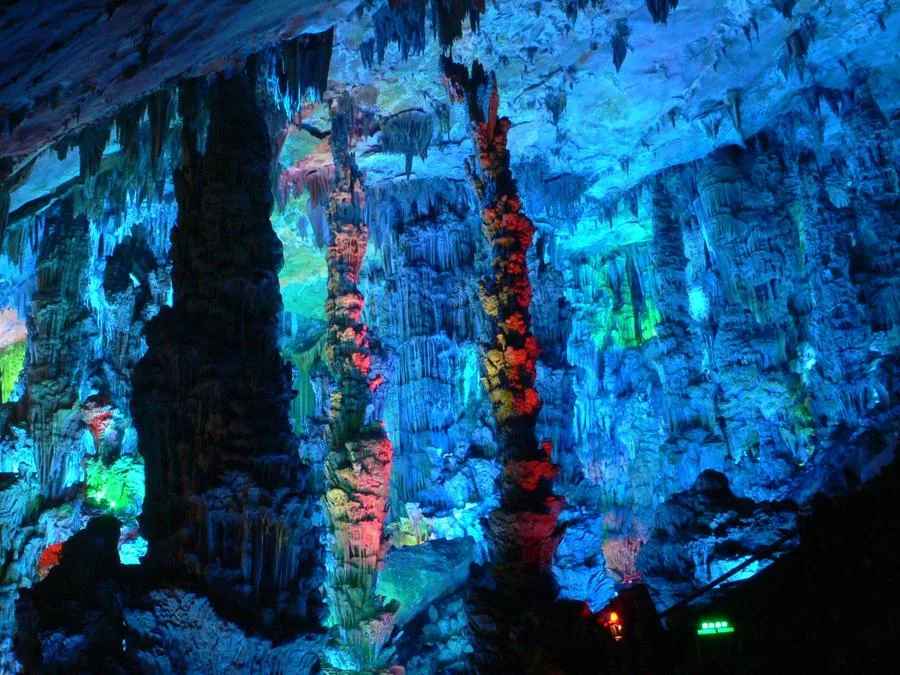Reed Flute Cave (芦笛岩), located in the northwest suburbs of Guilin, is a fascinating natural attraction renowned for its stunning karst formations. The cave extends 240 meters in depth, with a tour path of 500 meters. Its name derives from the reeds that once grew at its entrance, which were believed to make melodious flutes.
Inside the cave, visitors are greeted with an array of mesmerizing stalactites, stalagmites, columns, draperies, and flowers. These formations create a breathtaking landscape that includes features like the Lion Peak Morning Glow, Red Silk Pavilion, Dragon Pagoda, Primitive Forest, Crystal Palace, and Flower and Fruit Mountain. The cave’s intricate and delicate rock formations resemble a magical world, earning it the title of “Nature’s Art Palace.”
Reed Flute Cave has a long history of exploration, with visitors since the Tang Dynasty over a thousand years ago. The cave walls bear ancient inscriptions, with 77 wall paintings preserved from various dynasties.
Table of Contents
- Basic Information
- Location and Transportation
- Formation of Reed Flute Cave
- Highlights of Reed Flute Cave
- Vlog about Reed Flute Cave
- Other Iconic Attractions in Guilin
Basic Information
| Estimated Length of Tour | 1 – 2 hours |
| Ticket Price | 90 RMB |
| Opening Hours | 9.00 – 17.00 (1st January – 30th June); 8.00 – 17.30 (1st July – 31st December) |
| Telephone Number | 0086-0773-2210889 0086-0773-2695075 |
Location and Transportation
Reed Flute Cave is located in the northwest suburbs of Guilin, Guangxi Zhuang Autonomous Region, about 5 kilometers from the city center. The specific address is 1 Ludi Road. To get there, you can take Bus 3, Bus 213, or the 4A special line.
Formation of Reed Flute Cave
The cave’s formation is a result of a lengthy geological process. Approximately one million years ago, it was an ancient underground lake. As tectonic movements elevated the land and lowered the water table, the lake transformed into a cave. Rainwater then percolated through fractures in the rock, dissolving calcium carbonate and forming a solution rich in carbonate and calcium ions. As the water flowed into the cave and carbon dioxide escaped, calcium ions precipitated and crystallized, creating the diverse and spectacular stalactites and stalagmites seen today.
Highlights of Reed Flute Cave
Stalactites and Stalagmites of Unique Shapes

Reed Flute Cave is renowned for its naturally formed and densely packed stalactites and stalagmites, which exhibit rich and flowing lines with a grand and expansive presence. Enhanced by lighting, these formations create various visual effects, making the columns, stalagmites, stalactites, stone flags, and draperies appear as pieces of art. The cave offers a rich and colorful imaginative space and artistic enjoyment, resembling a grand palace of nature’s art. Highlights include the vibrant “Lion Peak Morning Glow,” the majestic “High Gorge Waterfall,” the elegant “Pine Tower in Snow,” the vast and grand “Primitive Forest,” the dreamlike “Crystal Palace,” the tranquil and unique “Secluded Realm Listening to the Flute,” and formations resembling snowmen, vegetables, koi fish, and conchs. Visitors can appreciate both the natural beauty sculpted by nature and the artistic enhancements provided by landscape designers, creating an experience akin to being in an art palace. The “Crystal Palace” stands out as the most remarkable feature. It is the widest part of the cave, ideal for indoor music performances, where the acoustics achieve a concert hall effect without any sound equipment.
Peach Blossom River

The Peach Blossom River, formerly known as Yang River, originates from Simoshan and Weiluoling in Lingchuan County, northwest of Guilin. It flows through Linqu and Lingchuan into Guilin, originally merging into the Li River at Zhishan. During the Ming Dynasty, a channel was dug at Xiangshan to direct it into the Li River. The river is approximately 25 kilometers long. Formed about 10,000 to 20,000 years ago, the river once had a wider and more substantial flow. Over time, the climate cooled, reducing water volume and causing the water level to drop, while the ground elevated, narrowing the river channel. The river now meanders with dozens of large bends and hundreds of small ones, forming a large “S” shape and two smaller “S” shapes in the Guilin area, resembling green ribbons winding through the karst basin of northern Guilin. Flowing through limestone regions, the water is clear, and areas between Feiluan Bridge and Shengli Bridge feature gentle, mirror-like waters with peaks reflected in them. The riverbanks are adorned with fiery oleander flowers, picturesque countryside, and mountains like Furong Mountain, Zhongyin Mountain, Shishan, Qingxiu Mountain, and Jia Mountain. The autumn moonlit scenery is especially beautiful.
Feiluan Bridge

The first notable feature visitors encounter upon entering the Reed Flute Cave Scenic Area is the dignified and ancient Feiluan Bridge. Also known as Feilong Bridge, it is located at the intersection of Peach Blossom River and Reed Flute Road. According to the history of Linqu County, the bridge was originally built with five stone arches during the Shaoding period of the Song Dynasty (1228-1233) and was named Feilong Bridge. It was rebuilt during both the Ming and Qing Dynasties. In the 6th year of the Yongzheng era (1728), local donors, including a man named Yu Bisheng, funded the reconstruction, which is commemorated by an inscription. The bridge was destroyed by war in the autumn of 1941 and was rebuilt in 1944 using wooden planks after locals raised over 400 piculs of rough rice. After the development of Reed Flute Cave, it was reconstructed into a three-arch stone bridge in 1964, and completed in April 1967. It was then named “Worker-Peasant Bridge.”
Wall Inscriptions

Reed Flute Cave is not only famous for its unique and majestic scenery but also for its historical wall inscriptions. These ancient inscriptions, referred to as “wall calligraphy,” include a collection of writings from various periods. There are a total of 77 wall inscriptions in the cave, comprising five from the Tang Dynasty, eleven from the Song Dynasty, one from the Yuan Dynasty, four from the Ming Dynasty, four from the Republic of China, and 52 of unknown dates. Among these, the most well-preserved and clearly legible inscription is from the Ming Dynasty, attributed to the mountain collection team of the Jingjiang Wang Mansion. It reads: “On the 16th day of the 10th month of the Dingchou year, the mountain collection team led by Zhang Wei, Wang Maoxiang, and Zhang Wenhui, among others, visited this place for the purpose of selecting stones for the construction of the Wang Mansion and tombs.” This inscription measures 50 centimeters in height and 58 centimeters in width, with a character diameter of 6 centimeters, reflecting the Wang Mansion’s historical practice of sourcing materials here.






The Reed Flute Cave in Guilin is a stunning sight. The red dawn cypress trees are ablaze with color, surrounded by emerald waters. The reflection of the covered bridge and the vibrant scenery makes every moment feel like a painting. Winter in Guilin offers both the warmth of the red cypress and the gentle touch of the green waters, creating a symphony of blue, yellow, orange, and green. The atmosphere is simply captivating!
I took a taxi to the entrance of the Reed Flute Cave and remembered to buy my tickets an hour in advance. They only allow entry at scheduled times because there is a guided tour. I arrived at 2:30 PM, just in time for the ticket check, so I didn’t waste any time. Once inside, I followed the guide, and it was quite beautiful. The whole tour lasted about an hour. It wasn’t cold inside; at least compared to the… Read more »
The Reed Flute Cave is truly magnificent. At this time, there aren’t many people around, and the air is fresh, making for a very pleasant experience.